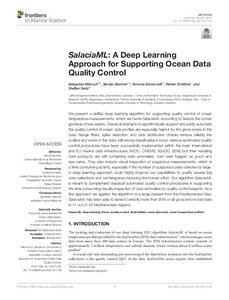| dc.contributor.author | Mieruch, Sebastian | |
| dc.contributor.author | Demirel, Serdar | |
| dc.contributor.author | Simoncelli, Simona | |
| dc.contributor.author | Schlitzer, Reiner | |
| dc.contributor.author | Seitz, Steffen | |
| dc.date.accessioned | 2021-05-05T16:10:36Z | |
| dc.date.available | 2021-05-05T16:10:36Z | |
| dc.date.issued | 2021 | |
| dc.identifier.citation | Mieruch, S., Demirel, S., Simoncelli, S.,
Schlitzer, R. and Seitz, S. (2021)
SalaciaML: A Deep Learning
Approach for Supporting Ocean Data
Quality Control.
Frontiers in Marine Science, 8:611742, 10pp.
DOI: 10.3389/fmars.2021.611742 | en_US |
| dc.identifier.uri | http://hdl.handle.net/11329/1560 | |
| dc.identifier.uri | http://dx.doi.org/10.25607/OBP-1056 | |
| dc.description.abstract | We present a skillful deep learning algorithm for supporting quality control of ocean
temperature measurements, which we name SalaciaML according to Salacia the roman
goddess of sea waters. Classical attempts to algorithmically support and partly automate
the quality control of ocean data profiles are especially helpful for the gross errors in the
data. Range filters, spike detection, and data distribution checks remove reliably the
outliers and errors in the data, still wrong classifications occur. Various automated quality
control procedures have been successfully implemented within the main international
and EU marine data infrastructures (WOD, CMEMS, IQuOD, SDN) but their resulting
data products are still containing data anomalies, bad data flagged as good and
vice-versa. They also include visual inspection of suspicious measurements, which is
a time consuming activity, especially if the number of suspicious data detected is large.
A deep learning approach could highly improve our capabilities to quality assess big
data collections and contemporary reducing the human effort. Our algorithm SalaciaML
is meant to complement classical automated quality control procedures in supporting
the time consuming visually inspection of data anomalies by quality control experts. As a
first approach we applied the algorithm to a large dataset from the Mediterranean Sea.
SalaciaML has been able to detect correctly more than 90% of all good and/or bad data
in 11 out of 16 Mediterranean regions. | en_US |
| dc.language.iso | en | en_US |
| dc.rights | Attribution 4.0 International | * |
| dc.rights.uri | http://creativecommons.org/licenses/by/4.0/ | * |
| dc.subject.other | Deep learning | en_US |
| dc.subject.other | Keras | en_US |
| dc.subject.other | Quality control | en_US |
| dc.subject.other | SeaDataNet | en_US |
| dc.subject.other | Ocean Data View | en_US |
| dc.subject.other | Temperature profiles | en_US |
| dc.title | SalaciaML: A Deep Learning Approach for Supporting Ocean Data Quality Control. | en_US |
| dc.type | Journal Contribution | en_US |
| dc.description.refereed | Refereed | en_US |
| dc.format.pagerange | 10pp. | en_US |
| dc.identifier.doi | 10.3389/fmars.2021.611742 | |
| dc.subject.parameterDiscipline | Parameter Discipline::Cross-discipline | en_US |
| dc.subject.dmProcesses | Data Management Practices::Data quality control | en_US |
| dc.bibliographicCitation.title | Frontiers in Marine Science | en_US |
| dc.bibliographicCitation.volume | 8 | en_US |
| dc.bibliographicCitation.issue | Article 611742 | en_US |
| dc.description.sdg | 14.A | en_US |
| dc.description.eov | Sea surface temperature | |
| dc.description.eov | Subsurface temperature | |
| dc.description.maturitylevel | TRL 9 Actual system "mission proven" through successful mission operations (ground or space) | en_US |
| dc.description.bptype | Manual (incl. handbook, guide, cookbook etc) | en_US |
| obps.contact.contactname | Sebastian Mieruch | |
| obps.contact.contactemail | sebastian.mieruch@awi.de | |
| obps.resourceurl.publisher | https://www.frontiersin.org/articles/10.3389/fmars.2021.611742/full | en_US |
 Repository of community practices in Ocean Research, Applications and Data/Information Management
Repository of community practices in Ocean Research, Applications and Data/Information Management

